Matchday two of the 2022 FIFA World Cup saw Qatar’s hopes of making it out of the group stage at their home World Cup disintegrate as they fell to a second straight defeat, this time losing 3-1 to Senegal following their opening day 2-0 loss to Ecuador. They now sit four points behind the top two in their group and will not progress beyond the group stage.
Their opponents, Senegal, however, have now set up a matchday three playoff with Ecuador that could potentially decide which of them makes it into the knockout stage, with group leaders the Netherlands taking on Qatar in a must-win clash for their final group stage fixture.
Senegal came into this game with a simple task: win. They lost their group stage opener versus the Netherlands and needed to win this one to realistically keep their chances of progressing further into the tournament alive. They managed to do so via a dominant scoreline but not a superbly impressive performance.
Meanwhile, there were some positives for Qatar to take from this game in terms of their performance, as despite the obvious gulf in quality between them and Senegal, they managed to frustrate their opponents throughout the game, limiting them to very few clear-cut chances and managing to create a couple of decent chances of their own on the counter, the quality of which would match up fairly well with the quality of Senegal’s best chances of the game.
This tactical analysis piece aims to provide some in-depth analysis of the key tactical talking points from this World Cup fixture. Our analysis will look at some of the key tactics deployed by both Qatar and Senegal during this game while looking at exactly how the two sides matched up with one another and what tactical components influenced the match that we saw play out, ultimately, in Senegal’s favour.
Lineups
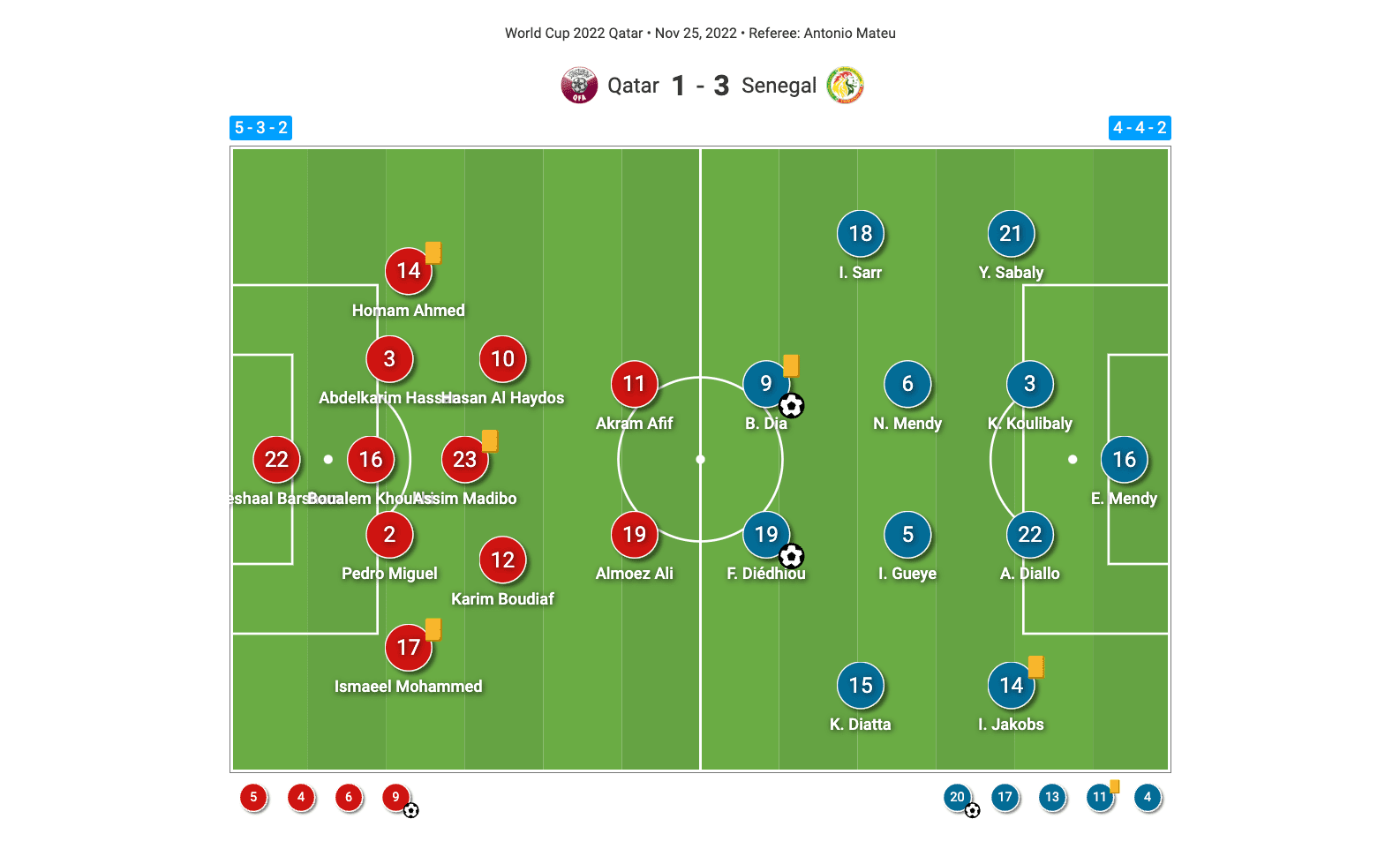
Host nation Qatar lined up in a 5-3-2 shape, as seen in figure 1, for this game. Meshaal Barsham started in goal behind right wing-back Ismail Mohamad, right centre-back Pedro Miguel, centre-back Boualem Khoukhi, left centre-back Abdelkarim Hassan and left wing-back, Homam Ahmed.
In midfield, coach Félix Sánchez went with Karim Boudiaf on the right, Assim Madibo in the middle and Hassan Al-Haydos on the left. Then lastly, up front, Sánchez lined up with Akram Afif and Almoez Ali.
Sánchez went on to make four substitutions during the game, the first of which came in the 69th minute as Abdulaziz Hatem took over from Boudiaf in midfield. This was closely followed by eventual goalscorer Mohammed Muntari replacing Al-Haydos in the 74th minute. Qatar’s final two substitutions came together in the 83rd minute with Mohammed Waad replacing Miguel and Tarek Salman coming on for Ahmed.
As for their opponents, victorious Senegal, they lined up in a 4-4-2 / 4-2-3-1 system. UEFA Champions League winner Édouard Mendy of EPL giants Chelsea started in goal for the Lions of Teranga behind right-back Youssouf Sabaly, Mendy’s club teammate Kalidou Koulibaly at right centre-back, Abdou Diallo at left centre-back and Ismail Jakobs at left-back.
In midfield, coach Aliou Cissé went with Ismaïla Sarr on the right, Nampalys Mendy and Idrissa Gueye in the centre alongside Krépin Diatta on the left. Then, lastly, Cissé deployed a front two consisting of Boulaye Dia and Famara Diedhiou.
Senegal made five changes to that starting lineup before the final whistle blew at the end of the game; the first of these changes came in the 64th minute as Fathé Ciss took over from Diatta. 10 minutes after that, in the 74th minute, Senegal made another two substitutions with Bamba Dieng coming on for Diedhiou and Iliman Ndiaye taking the place of Sarr.
Cissé followed this up with a final double-substitution in the 77th minute as Pape Matar Sarr came onto the pitch in place of Mendy and Pape Abou Cissé took over from Jakobs in the backline.
Senegal in possession, Qatar without possession
Without further ado, let’s move on to the tactical analysis. Our first section looks at Senegal in possession and Qatar without possession, as Senegal, unsurprisingly, ended up having more of the ball in this game (52.66% to Qatar’s 47.34%, in the end).
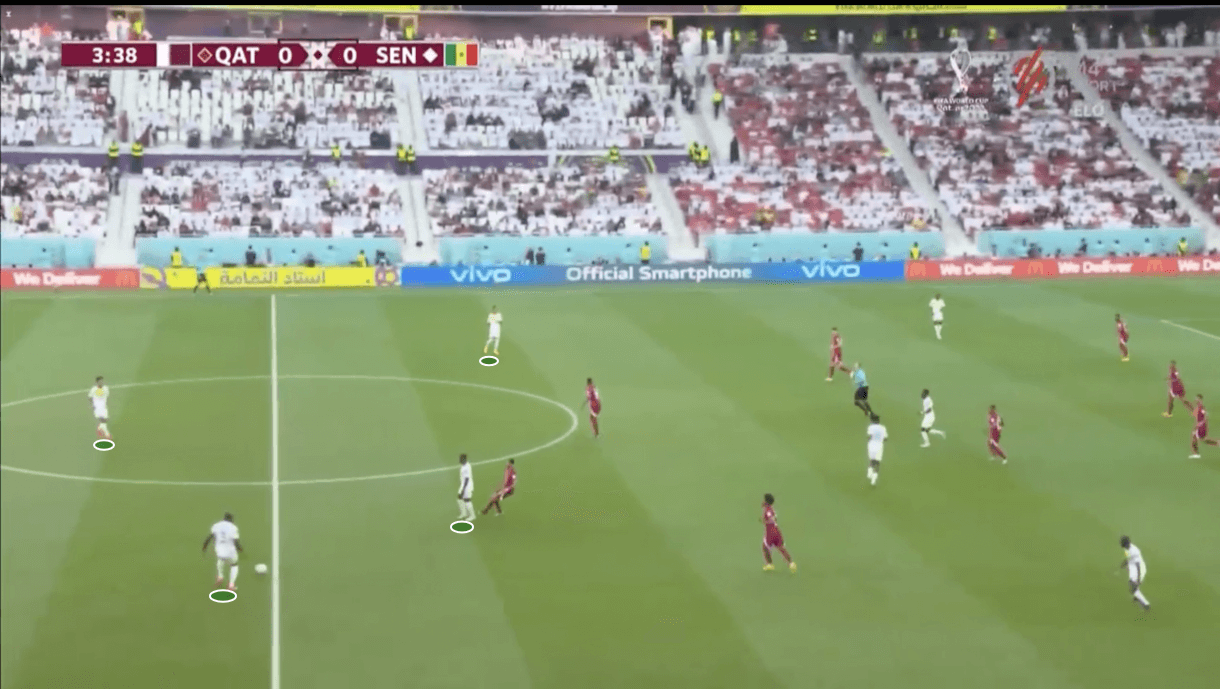
Senegal played with a 2-2 base in possession, made up of the two centre-backs and the two central midfielders, which figure 2 displays. The full-backs pushed on to provide wide options further upfield alongside the wingers. Meanwhile, Senegal’s two wingers would tuck inside a bit at times during the ball progression phase, the phase of play that they spent the majority of their time with the ball in, to provide options slightly more centrally in between the lines of Qatar’s 5-3-2 defensive shape.
The Lions of Teranga required more than just the wingers between the lines, so the centre-forwards would also alternate their movement between dropping deep and sitting high on the last line to continue providing different progressive passing options for the deeper players during the progression phase. This dynamic movement from four players in between the lines in central areas was key for Senegal’s ball progression and movement into the final third, yet still, they struggled to break Qatar down due to the hosts’ organisation and defensive work rate.
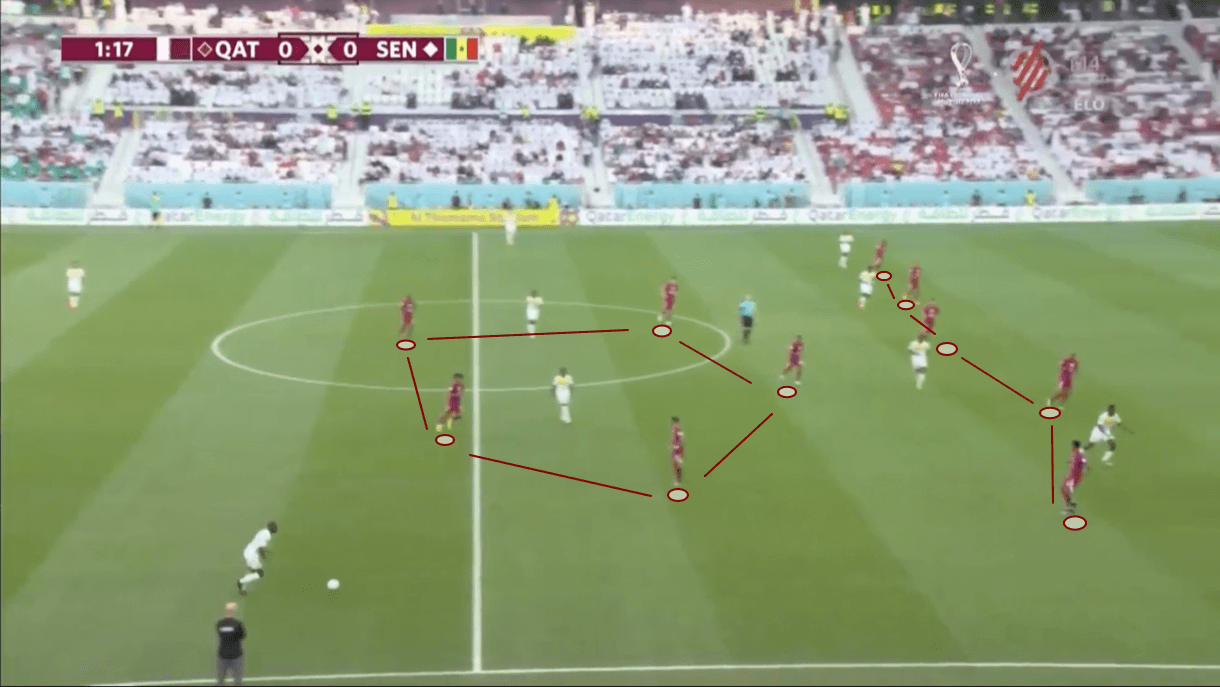
Qatar’s 5-3-2, as seen clearly in figure 3, was primarily designed to congest the middle of the pitch. In the image above, Qatar’s forwards and midfielders form a pentagon around the Lions of Teranga’s midfield duo, cutting off access into them from deeper (though Qatar’s players wouldn’t follow the Senegal midfielders if they dropped deeper or wider, they just wanted to prevent them from receiving centrally).
In more advanced stages of the attack or if the midfielders dropped and got on the ball outside of the central area, Qatar’s position-oriented defensive shape would remain focused on controlling the most valuable central areas that Senegal could realistically play the ball forward into, especially denying the forwards and wingers space to receive centrally between the midfield and defensive lines.
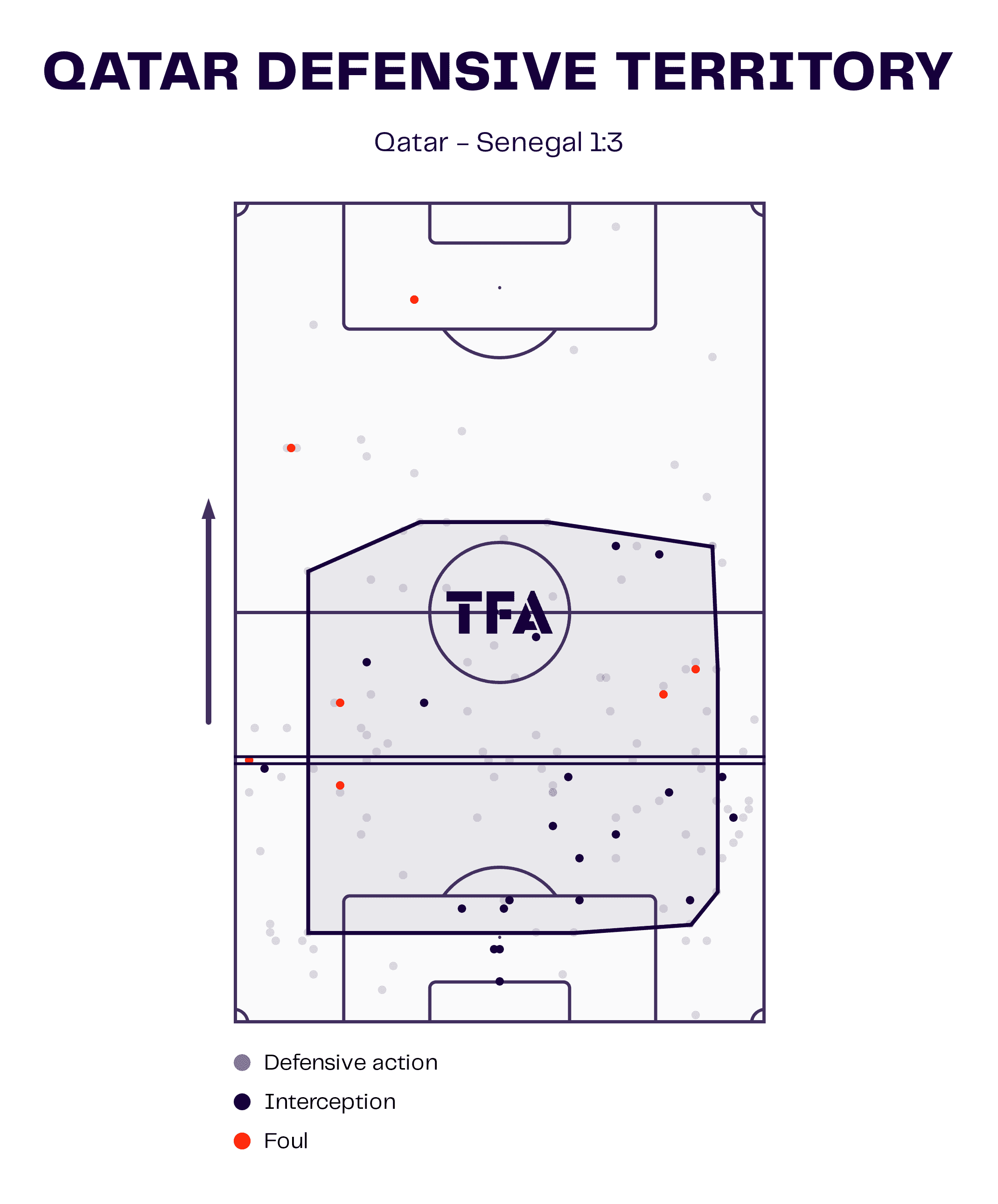
Figure 4 shows Qatar’s defensive territory for this game; here, we can see their average area of engagement and the average height of their defensive line.
This image further demonstrates how well they protected the middle of the pitch in and around their penalty area, preventing Senegal from playing through those areas where they’d positioned their wingers and forwards, and especially the half-spaces, which Senegal tried to use to break into the final third but were routinely denied by Qatar’s organised defence — as the general positioning of Qatar’s interceptions and defensive actions above indicates.
We were impressed by Qatar’s defensive organisation and fight in this game, they were very good without the ball and did well to frustrate Senegal throughout the game, giving them very few chances to break through their shape and create clear-cut chances. They managed to generate plenty of interceptions and successful defensive duels, making 73 recoveries in total (to Senegal’s 67) in this game.
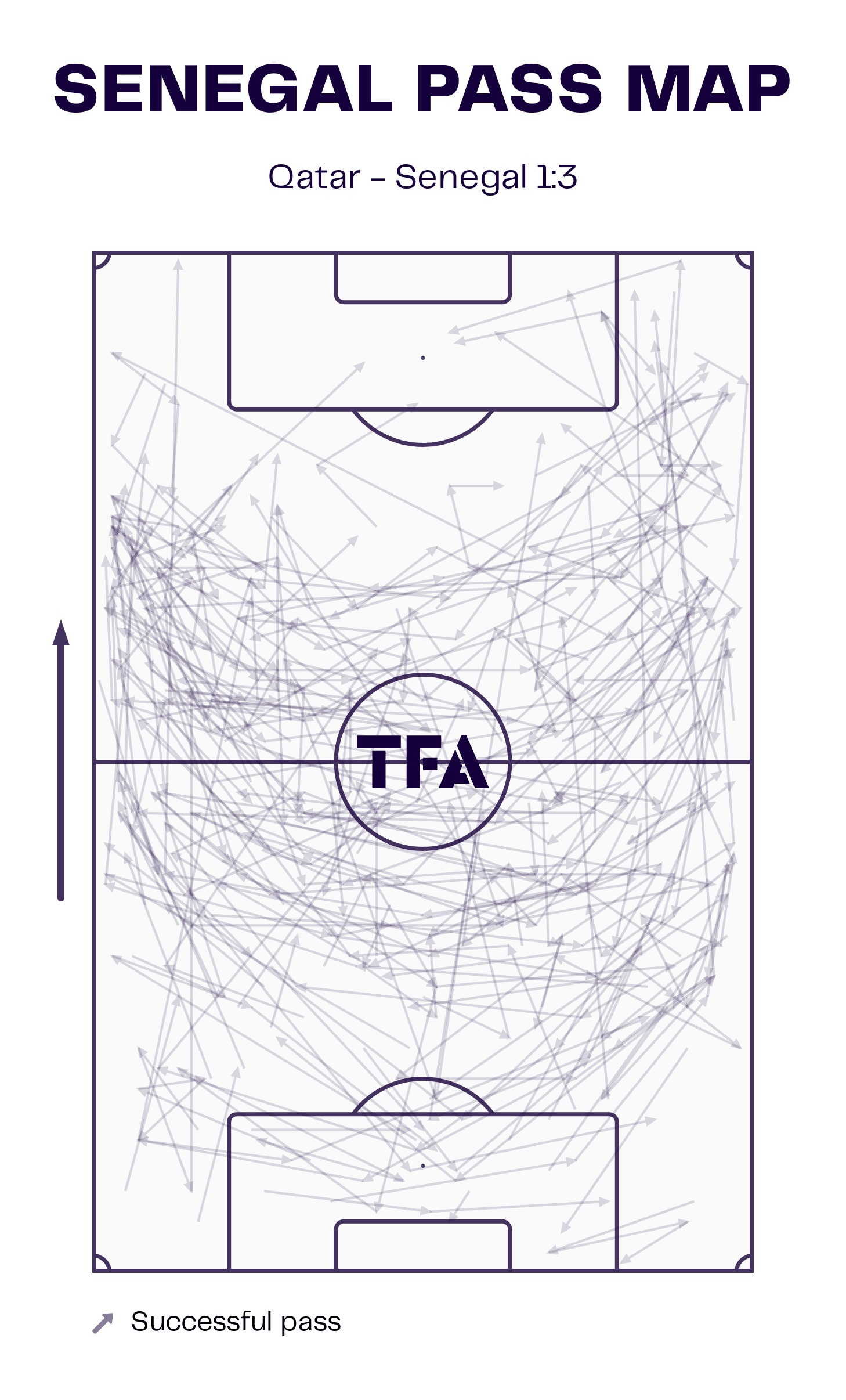
Cissé’s side entered Qatar’s penalty area just 23 times in the fixture — just five more occasions than Qatar entered Senegal’s penalty area. Qatar’s dominant defence in the central areas around their box and disciplined, organised implementation of their manager’s plan were the key reasons for this failure to generate more penalty area entries. Figure 5 shows Senegal’s pass map from Friday’s fixture and it tells the story of a side struggling to break into the central space just in front of the box. They had no joy passing through these areas.
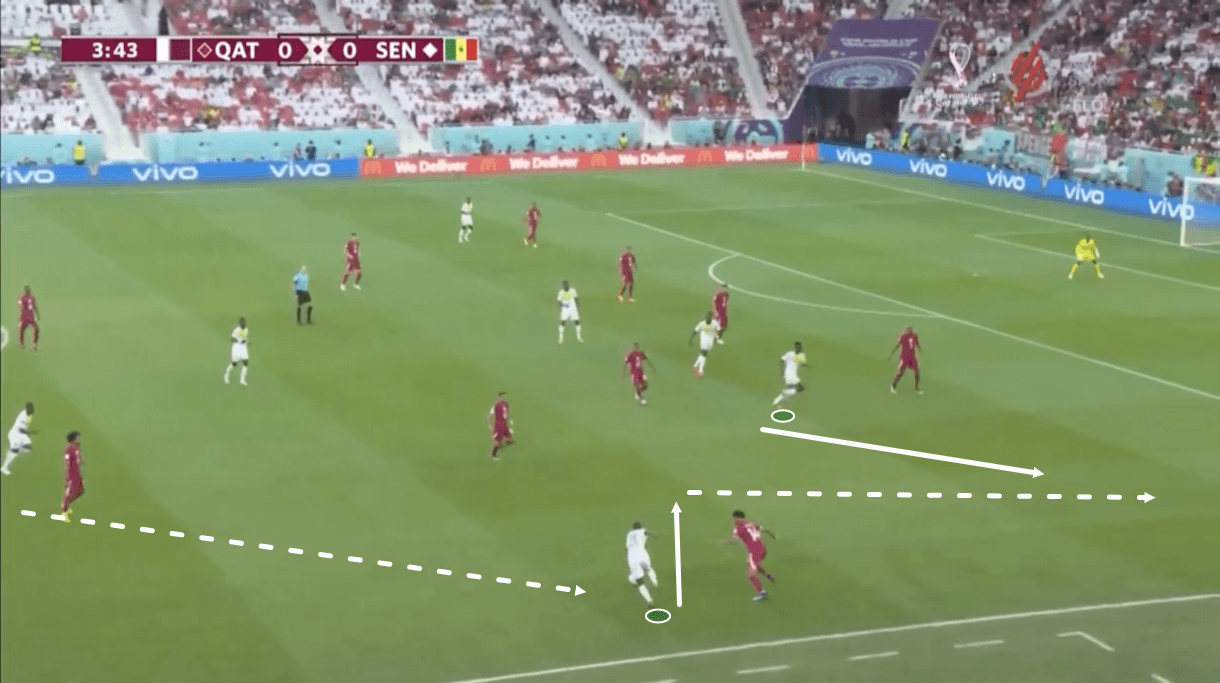
As a result of this, one strategy Senegal used to great success in generating chances versus Qatar was wide overloads. While Qatar protected the centre like animals, they were then vulnerable out wide. While their wide central midfielders and wing-backs had the license to approach the Senegal full-back/winger if they received deep out wide, it wasn’t always possible to close them down quickly enough before the Senegal attackers could do damage and slice Qatar open, as was the case in figure 6.
Here, in this example, the Senegal right-back Sabaly has just received in a fairly deep wide position, drawing Qatar’s left wing-back out to him. However, by the time the wing-back reaches him, the right-back has already decided on and started to execute his next move. He carries the ball inside, spots the in-to-out run from right-winger Sarr and slides the ball through into Sarr’s path, sending Senegal into the final third and creating a good crossing opportunity.
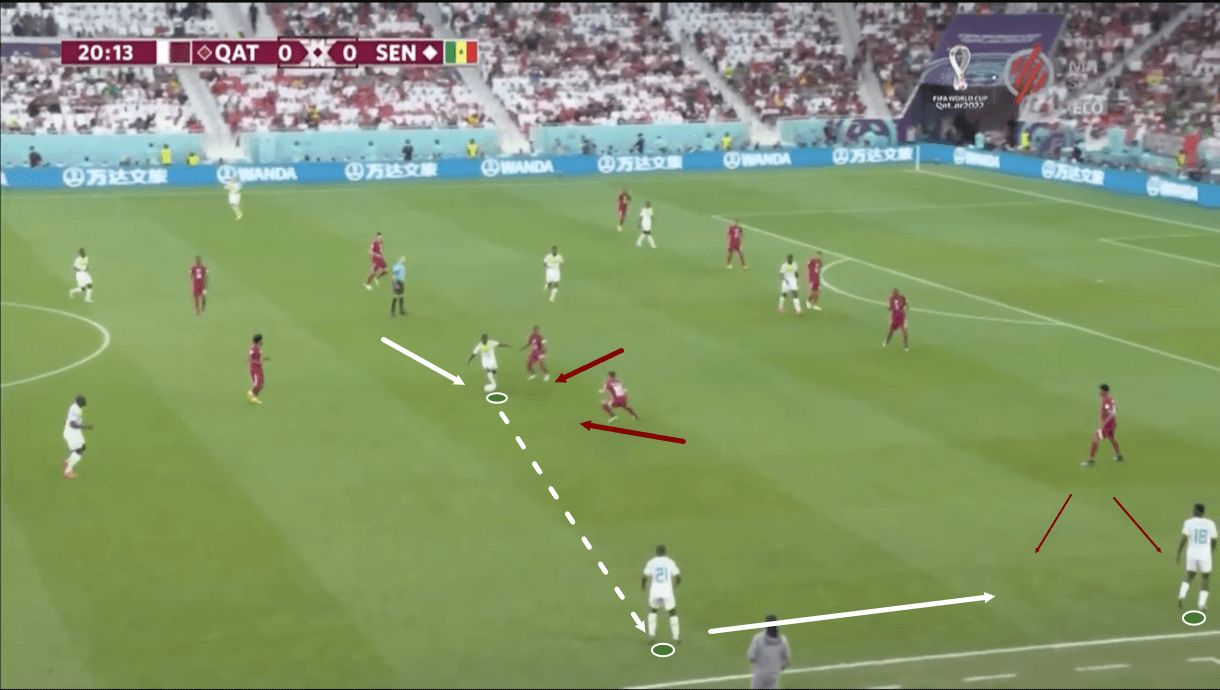
We see another example of the wide overload working in Senegal’s favour in figure 7. Here, the Senegal right-back receives out wide from a central midfielder whose carry has attracted pressure from Qatar’s left central midfielder and middle central midfielder. As he plays the ball out wide to the right-back, he sets Sabaly up to move forward and overload Qatar’s left wing-back 2-1 with the winger, thanks to his carry which created this space by drawing Qatar’s left central midfielder in.
As play moves on from here, we see the right-back move forward, get his head up, note that the wing-back was focusing on Sarr rather than him, and send the ball into the box via a cross, creating what was, for Senegal in this game, a rare penalty box entry.
Two of Senegal’s three goals in this game came via wing play that created a successful cross and, ultimately, a goal, while the other came from a set piece. Without their wide overloads and successful wing play, Senegal would not have won this game so it was crucial for their success in this one and keeping their hopes of progressing deeper into the competition alive.
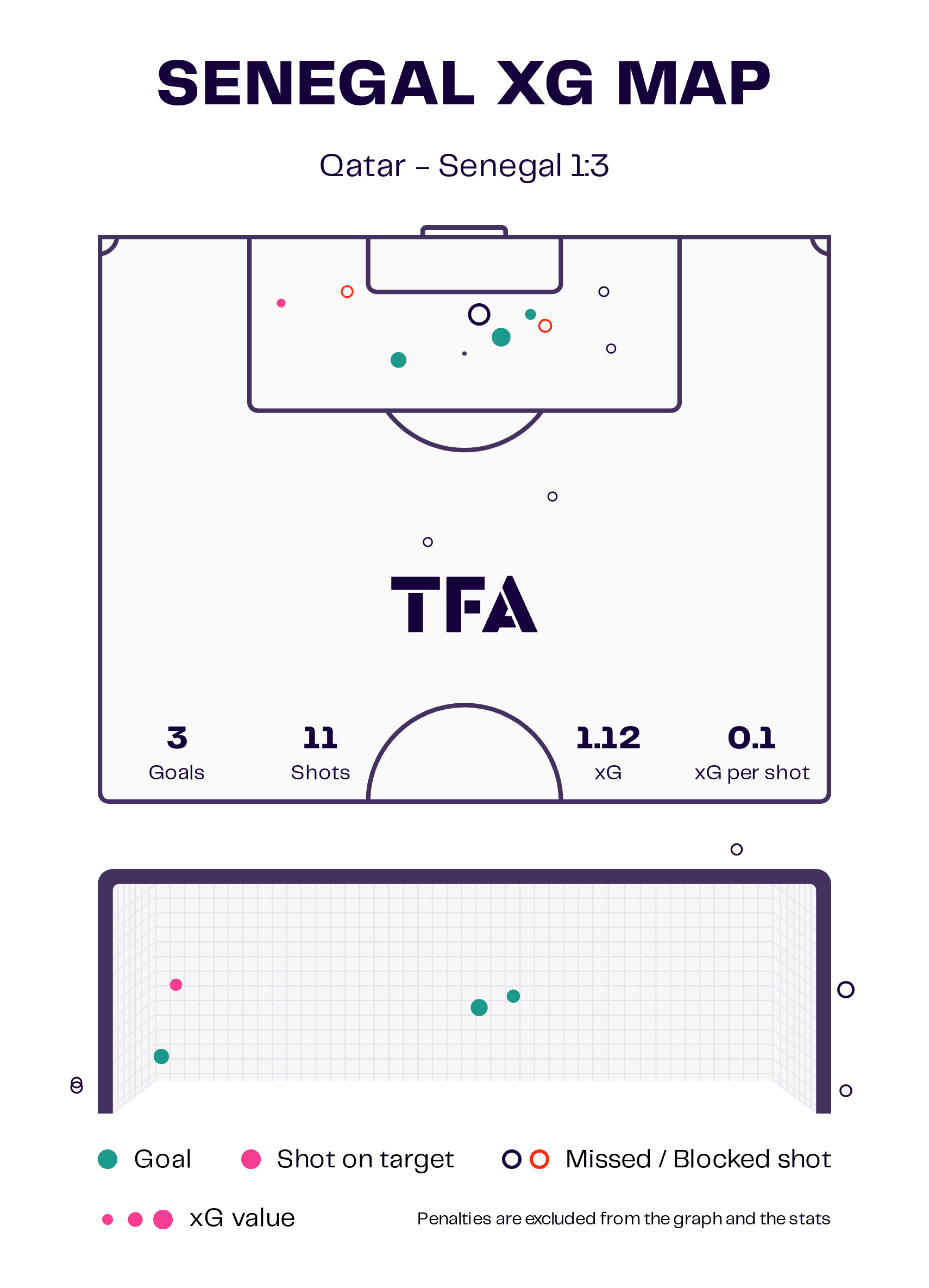
While they scored three goals, Senegal generated an xG of just 1.12 versus Qatar. This isn’t surprising given how little they managed to enter the Qatar penalty box and the fact they got just 11 shots off. They managed to take their chances in the end and secure the victory but the two-goal cushion flatters them, though they obviously did well to take their chances.
Transitions
Both of these teams would really be better suited to attacking in transition than positional attacks. As for Qatar, they did well to force plenty of turnovers via their successful defensive duels and interceptions as they frustrated Senegal on the edge of their box but failed to turn enough of these turnovers into good goalscoring chances on the counter. If they had managed to do so, then we may have a very different story coming out of this one.
Unfortunately for Qatar, their quality on the ball cost them at times, but they still did well to create some decent chances on the counter. At times, they used Senegal’s confidence and desire to dominate this contest against them as they lured the Lions of Teranga into committing a little too aggressively, drawing the defender in and then exploiting the space he’d left open behind him to create a decent goalscoring chance.
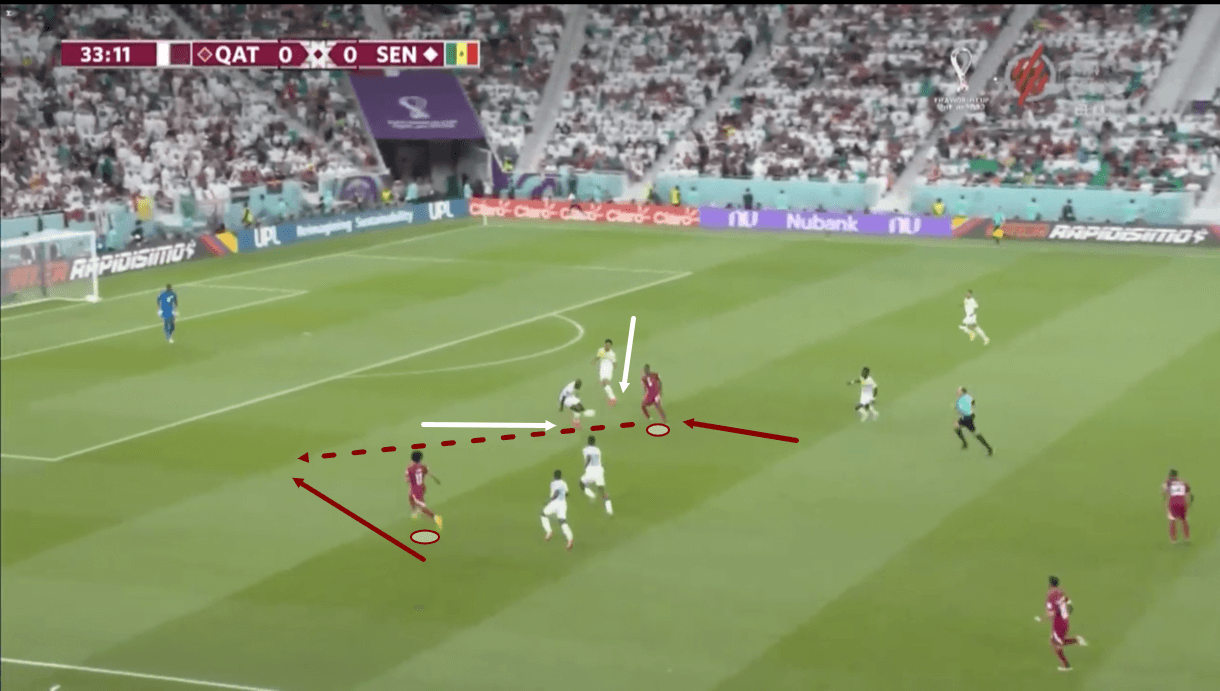
We see an example of this in figure 9. Qatar’s right-forward Ali has just carried the ball forward into the final third after receiving from a deeper teammate; in order to quickly stop this attack and get back on the ball, where they feel they belong, Senegal’s right centre-back Koulibaly brashly jumps from the backline to close down the receiver. This leaves space open on his side of the backline that Qatar can and do exploit.
This wasn’t Qatar’s goal, but their goal did come from a chance created via a big long ball that switched play from left to right, giving the receiver a chance to target space behind Senegal’s backline, and Qatar managed to create a few decent chances via this space behind the backline left open after some brash defending in this fixture, they did very well in transitional attacks.
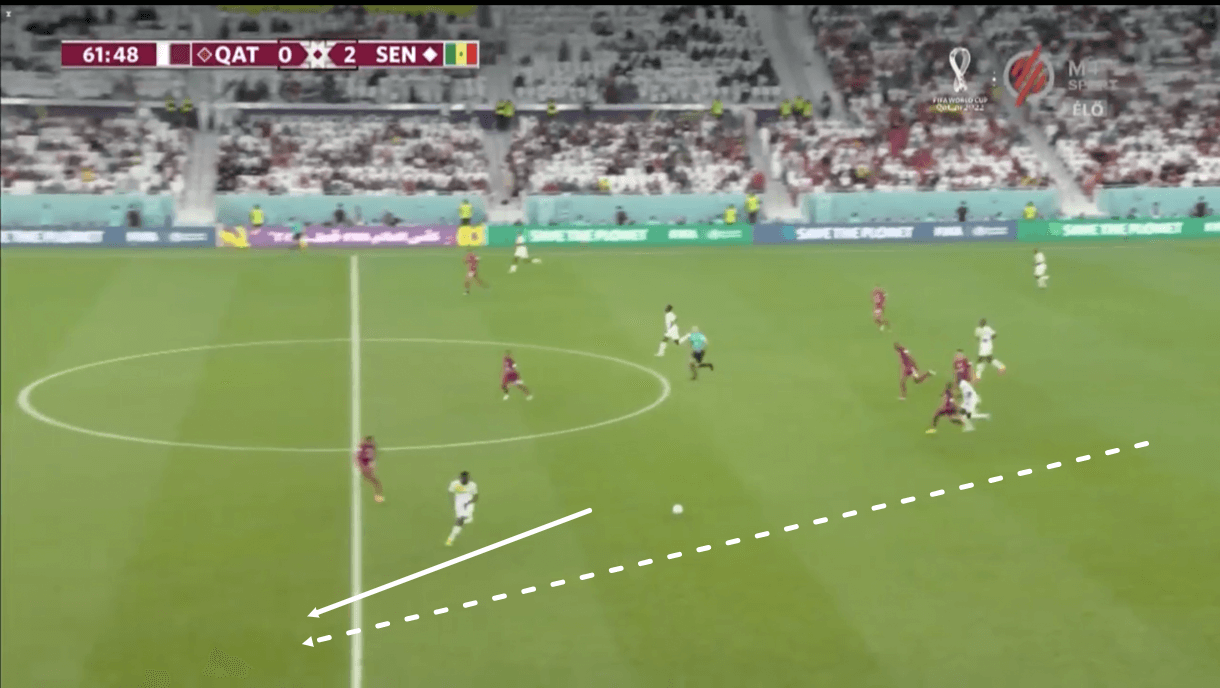
As for Senegal, in the early stages of the game, chances to counterattack were few and far between as Qatar opened up very little and left no space to attack in transition. As the game wore on, however, especially after Senegal picked up a two-goal lead, Qatar were forced into playing a bit more aggressively in search of a route back into the game and this created some opportunities for Senegal to counterattack in a more normal way for their style of play, as seen in figure 10.
It’s normal to see Senegal’s attackers running from in to out, attacking space on the wing during a transition to attack that a long ball from the back creates, so they managed to create some opportunities via this method as the game wore on. In the early stages, however, their opportunities to counter Qatar were few and far between — Sánchez’s side did well to eliminate this strength from Senegal’s game.
Qatar in possession, Senegal without possession
Our final section of analysis looks at Qatar’s play with the ball and Senegal’s play without the ball. Of course, Qatar retained less of the ball than Senegal did in this game but they still had plenty of it to generate some chances and demonstrate some interesting tactical ideas. The big problems for Qatar were not really tactical, but rather in terms of quality. The first thing that’s worth noting about Qatar’s approach in possession, then, is the important role played by Afif.
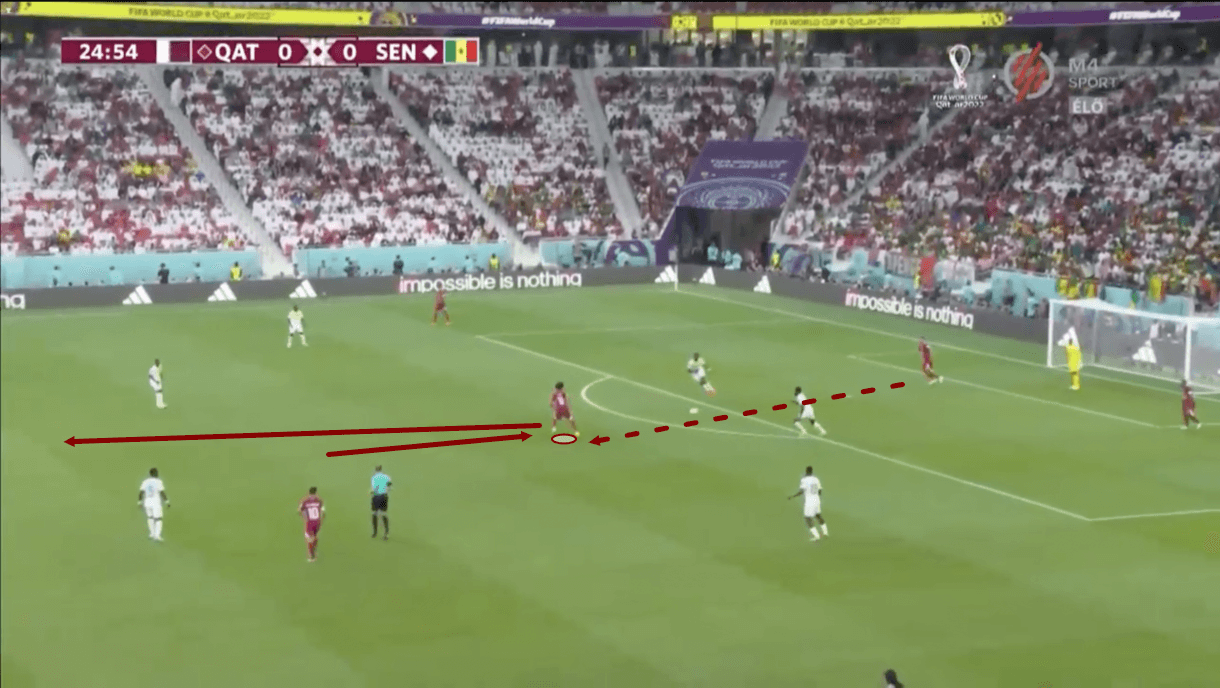
The 26-year-old Al-Sadd star lined up as a left-forward in the defensive system but when his side were in possession, he occupied a largely free role with a license to go where and do what he pleases. A lot of the time, we saw the forward drop extremely deep, as we see in figure 11, due to the fact that his teammates were simply struggling to get out from the back and needed a player of his quality to help progress past Senegal’s first line of defence, at times.
In the image above, we see how Afif’s movement created a good passing option for Qatar’s right centre-back behind Senegal’s forward line that none of the Senegalese players were prepared to deal with. As play moves on from here, we see Afif take the ball excellently on the half-turn and drive upfield with it, taking his team well into the middle third of the pitch.
Afif’s movement helped Qatar to numerically overload Senegal in places they didn’t necessarily expect to see him popping up and thus made it difficult to mark him, as we saw in this example.
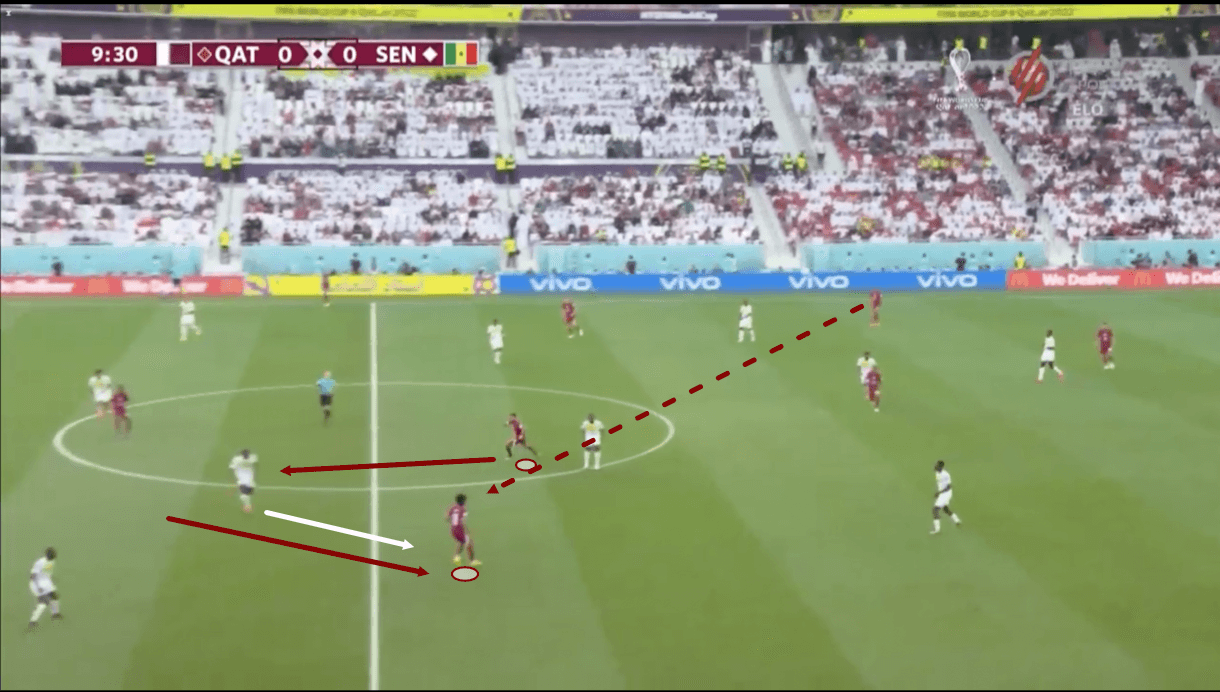
The player’s movement in more advanced positions helped kickstart some very nice rotations that created goalscoring opportunities, combining with Senegal’s tendency to defend a bit brashly in this game, as figures 12-13 show. In figure 12, we see Afif receiving the long ball from the back after dropping off into a deeper position, attracting Koulibaly with him. This creates space for a midfielder to advance behind Koulibaly into the space he’s vacated.
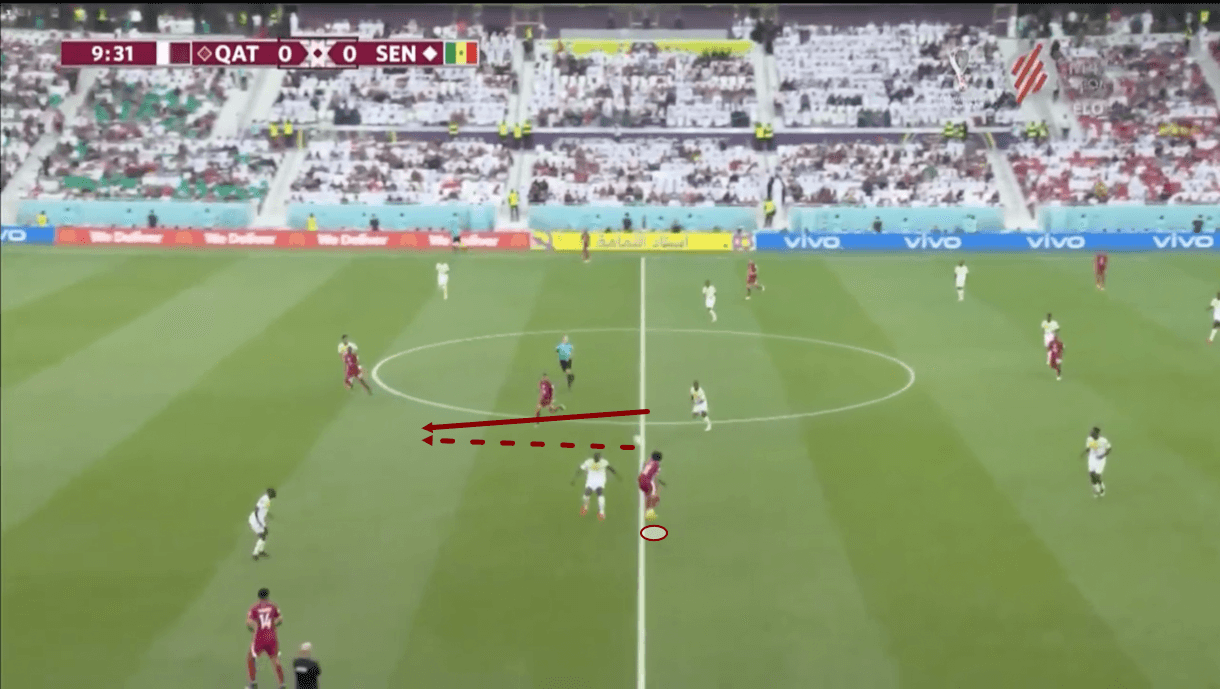
In figure 13, we see that Afif manages to knock the ball on into the midfielder’s running path, allowing him to receive and carry the ball on into the final third where he can play the left wing-back through on the overlap, creating a good goalscoring opportunity for Qatar.
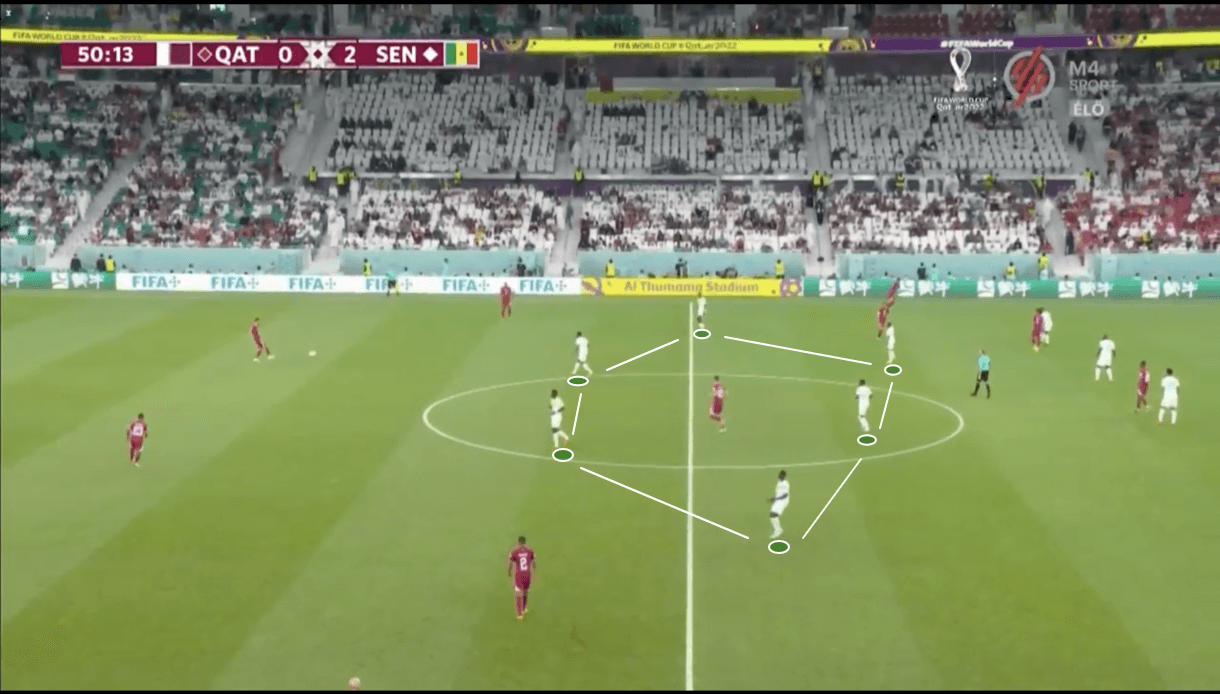
In the build-up, Qatar switched to a four-at-the-back system, with their left wing-back pushing higher to become essentially a wide midfielder (creating something of a 4-4-2 for Qatar in possession). Meanwhile, Senegal typically defended in a 4-4-2 and this allowed them to match up with Qatar’s backline man-for-man when they defended more aggressively, high up the pitch. However, their pressing wasn’t particularly aggressive for the most part in this game, as their PPDA of 14.26 (to Qatar’s 18.39) would indicate.
Senegal generally don’t press very aggressively and while they pressed quite aggressively for parts of this game, they really toned it down after going two goals up early in the second half, dropping off into more of a mid-block for the most part then, which looked like we see in figure 14, with six players surrounding the central midfield area, making it difficult for Qatar to play through them.
Senegal’s early pressure on the backline and later midfield congestion forced Qatar into uncomfortable long balls that their deeper players didn’t always have the quality to pull off, leading to cheap turnovers in favour of Senegal.
If one of Senegal’s forwards decided to press more aggressively in a situation like this, the other needed to drop onto the midfielder, ensuring he didn’t become a free man between the forward and midfield lines. This was an intelligent bit of tactical decision-making that allowed pressure to be applied to the backline while still blocking off that pass into midfield that could slice Senegal open.
Generally speaking, Senegal’s pressing forward in the more advanced areas would cut the passing lane between the two centre-backs first and foremost before closing down the ball carrier. This effectively cut the pitch in half and significantly narrowed their field of play.
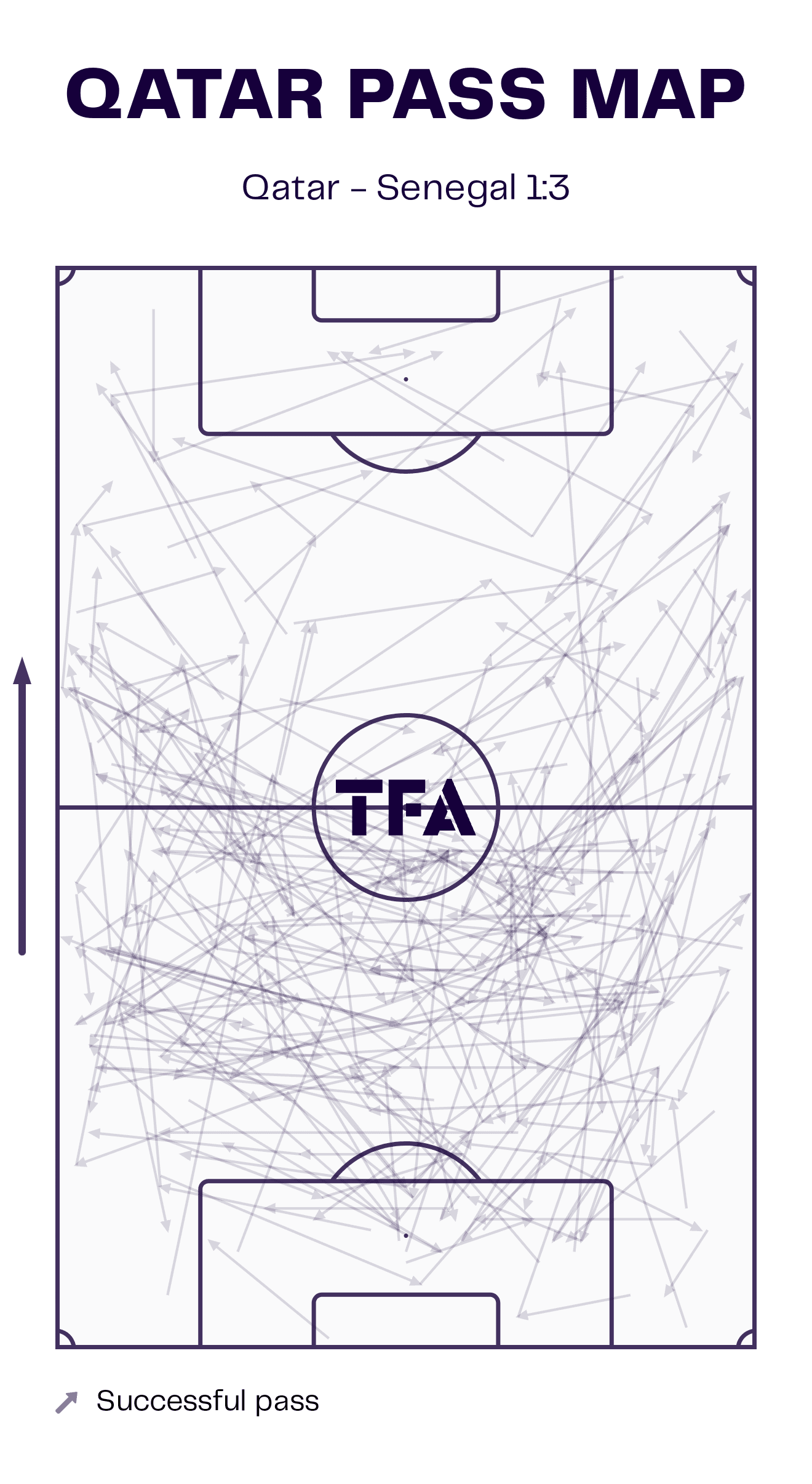
Sánchez’s side rarely made it out of their half. They made plenty of passes in deeper areas, especially in the later stages of the game — they ended the contest with 401 passes to Senegal’s 500. However, many of their passes were short lateral or backward passes in harmless areas. They struggled to make their way upfield safely and were forced into a lot of long balls by Senegal’s defensive tactics. This is why despite playing almost 100 fewer passes, Qatar played 77 long balls to Senegal’s 52.
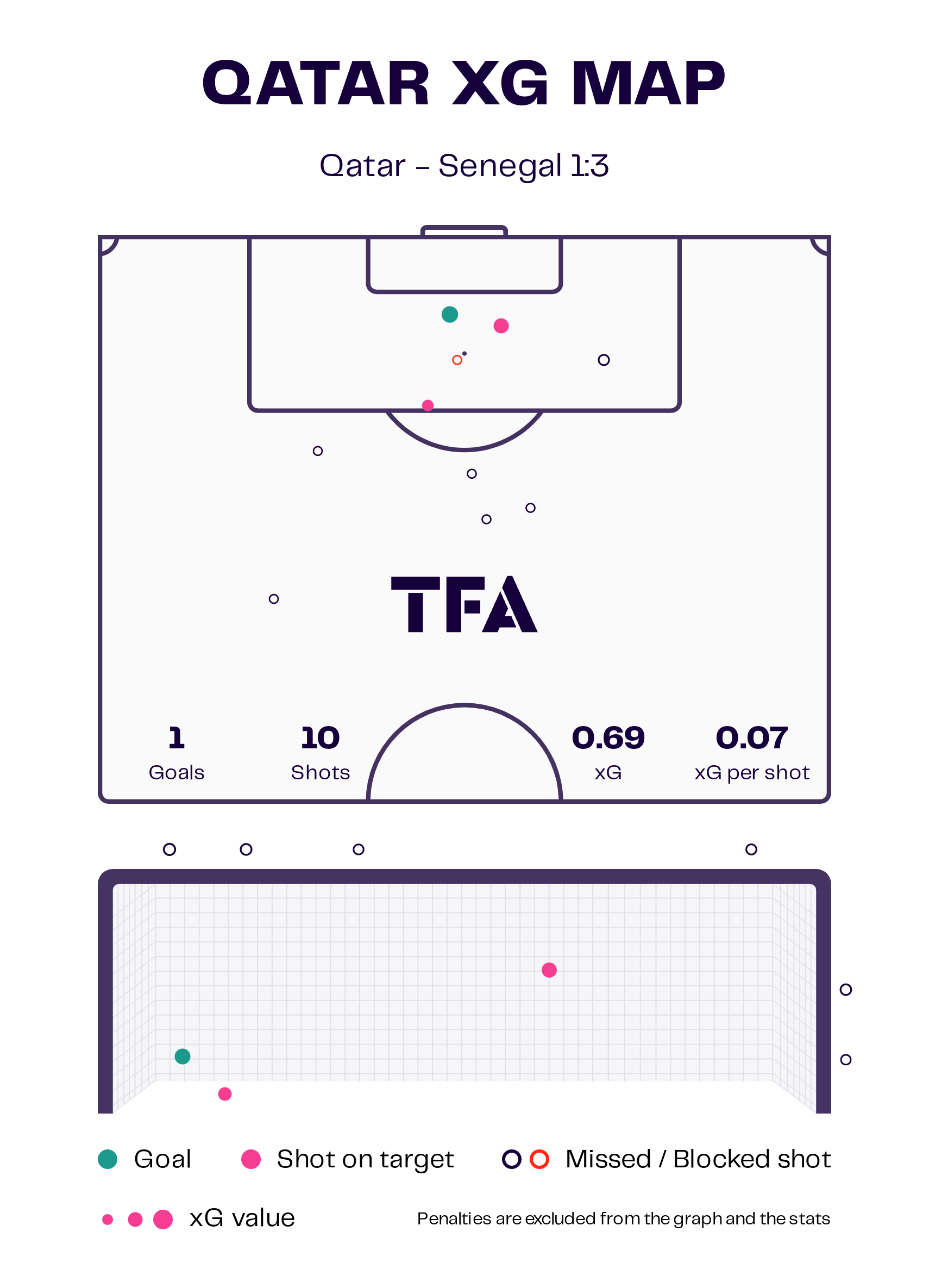
Still, Qatar created just one less shot than Senegal, generating an 0.69 xG — more of a testament to their impressive defensive ability to limit Senegal to so few chances and create so many opportunities to attack in transition than it is a testament to any elite attacking quality they possess.
Conclusion
To conclude this tactical analysis, if there had to be a winner from the game, it’s safe to say it should’ve been Senegal as they were ultimately more dominant and created better chances. However, Qatar delivered a decent tactical display, in our view, to make the significant gulf in quality between these two sides look far smaller than it actually is.

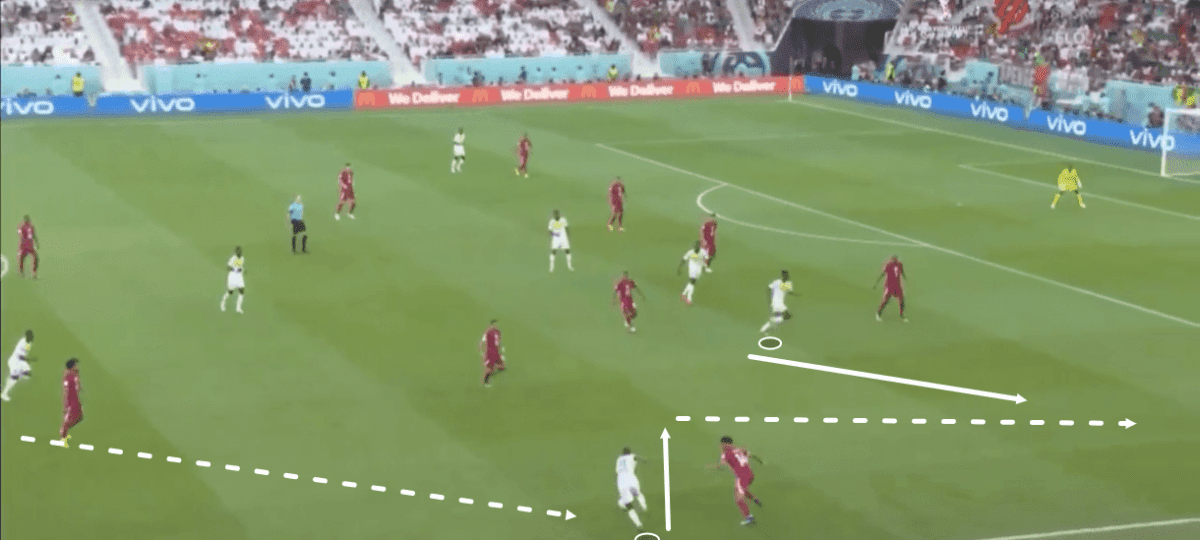



Comments